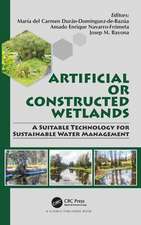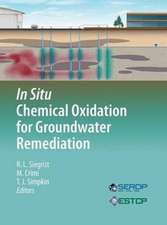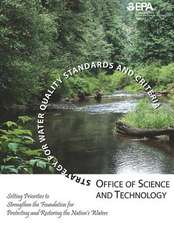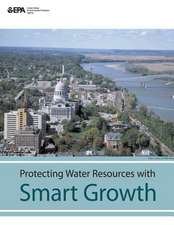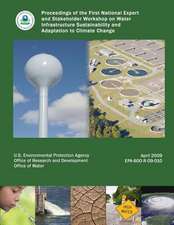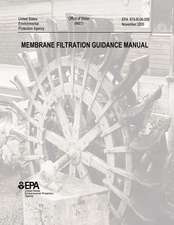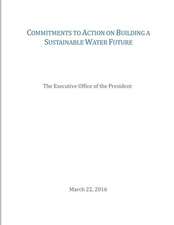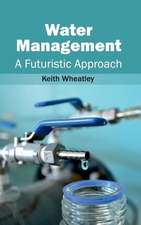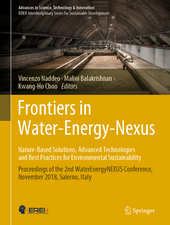Decentralized Water Reclamation Engineering: A Curriculum Workbook
Autor Robert L. Siegristen Limba Engleză Hardback – 11 noi 2016
The book provides in-depth engineering coverage of the subject in a narrative and slide format specifically designed for classroom lectures or facilitated self-study. Key topics are covered including: engineering to satisfy project goals and requirements including sustainability, contemporary water use and wastewater generation and methods to achieve water use efficiency and source separation, alternative methods of wastewater collection and conveyance, and treatment and reuse operations including tank-based (e.g., septic tanks, aerobic treatment units, porous media biofilters, membrane bioreactors), wetland-based (e.g., free water surface and vegetated subsurface bed wetlands), and land-based unit operations (e.g., subsurface soil infiltration, shallow drip dispersal). Approaches and technologies are also presented that can achieve nutrient reduction and resource recovery in some cases or pathogen destruction to enable a particular discharge or reuse plan. The book also describes requirements and methods for effective management of the process solids, sludges and residuals that can be generated by various approaches, technologies, and systems. The book contains over 300 figures and illustrations of technologies and systems and over 150 tables of design and performance data. There are also more than 200 questions and problems relevant to the topics covered including example problems that have solutions presented to illustrate engineering concepts and calculations.
| Toate formatele și edițiile | Preț | Express |
|---|---|---|
| Paperback (1) | 585.47 lei 38-44 zile | |
| Springer International Publishing – 23 iun 2018 | 585.47 lei 38-44 zile | |
| Hardback (1) | 1639.48 lei 38-44 zile | |
| Springer International Publishing – 11 noi 2016 | 1639.48 lei 38-44 zile |
Preț: 1639.48 lei
Preț vechi: 2129.19 lei
-23% Nou
Puncte Express: 2459
Preț estimativ în valută:
313.71€ • 328.42$ • 259.58£
313.71€ • 328.42$ • 259.58£
Carte tipărită la comandă
Livrare economică 02-08 aprilie
Preluare comenzi: 021 569.72.76
Specificații
ISBN-13: 9783319404714
ISBN-10: 3319404717
Pagini: 399
Ilustrații: LVI, 947 p. 347 illus., 180 illus. in color.
Dimensiuni: 155 x 235 x 50 mm
Greutate: 16.57 kg
Ediția:1st ed. 2017
Editura: Springer International Publishing
Colecția Springer
Locul publicării:Cham, Switzerland
ISBN-10: 3319404717
Pagini: 399
Ilustrații: LVI, 947 p. 347 illus., 180 illus. in color.
Dimensiuni: 155 x 235 x 50 mm
Greutate: 16.57 kg
Ediția:1st ed. 2017
Editura: Springer International Publishing
Colecția Springer
Locul publicării:Cham, Switzerland
Cuprins
Chapter 1. Introduction to Decentralized Infrastructure for Wastewater Treatment and Water Reclamation.- Chapter 2. System Selection, Design and Implementation.- Chapter 3. Contemporary Water Use and Wastewater Generation.- Chapter 4. Water Use Efficiency and Waste Stream Source Separation.- Chapter 5. Alternative Wastewater Collection and Conveyance in Decentralized Infrastructure.- Chapter 6. Treatment Using Septic Tanks.- Chapter 7. Treatment Using Aerobic Bioreactors.- Chapter 8. Treatment Using Porous Media Biofilters.- Chapter 9. Treatment Using Membrane Bioreactors.- Chapter 10. Treatment Using Constructed Wetlands.- Chapter 11. Treatment Using Subsurface Soil Infiltration.- Chapter 12. Treatment Using Landscape Drip Dispersal.- Chapter 13. Treatment for Nutrient Reduction.- Chapter 14. Treatment for Pathogen Reduction.- Chapter 15. Management of Process Solids, Sludges, and Residual.
Notă biografică
Dr. Robert L. Siegrist is University Professor Emeritus of Environmental Science and Engineering at the Colorado School of Mines (CSM) where he is also a Professor of Civil and Environmental Engineering. He earned his BS (High Honors) and MS degrees in Civil Engineering and his PhD degree in Environmental Engineering at the University of Wisconsin. While at the University of Wisconsin, Dr. Siegrist was a graduate student and research staff member with the Small Scale Waste Management Project, a large multidisciplinary research program focused on small systems for water and wastewater treatment and disposal/reuse. Before joining CSM in 1995, Dr. Siegrist held academic and research positions with the University of Wisconsin, Norwegian Institute for Georesources and Pollution Research, and Oak Ridge National Laboratory. Dr. Siegrist was also a founding partner and senior engineer with RSE Inc., an environmental consulting company that specialized in the engineering of decentralized systems for water and sanitation.
Dr. Siegrist served as Program Director for the Small Flows Program, which he established at CSM in 1998 to advance the science and engineering of sustainable decentralized approaches to water and sanitation. The Program was designed to enhance the quantitative understanding of processes important to system design and performance and to develop decision-support tools for applications involving individual houses and buildings up to those involving large developments, communities, and watershed-scale situations. To support research and teaching, a unique field test facility, the Mines Park Test Site, was established on the CSM campus. Dr. Siegrist is also developer of an undergraduate/graduate course covering the principles and practices of decentralized water reclamation and reuse, which he has taught for the past 10 years.
Dr. Siegrist is an internationally recognized expert in decentralized systems for wastewater treatment and water reclamation as well as remediation of contaminated soil and groundwater. He has published over 300 technical papers, 7 book chapters, and 2 textbooks. Dr. Siegrist has given invited lectures at more than 100 workshops and conferences in more than 30 countries worldwide. He was a founding Member of the Consortium of Institutes for Decentralized Wastewater Treatment, a group of 25 educational institutions cooperating on training and research efforts in the area of decentralized wastewater treatment and water reclamation. During his career Dr. Siegrist has served as a science and engineering advisor to numerous U.S. and foreign companies, organizations and agencies and has been a Fellow with the NATO Committee for Challenges to Modern Society.
Textul de pe ultima copertă
This book presents technical information and materials concerning the engineering of decentralized infrastructure to achieve effective wastewater treatment while also minimizing resource consumption and providing a source of reclaimed water, nutrients and organic matter. The approaches, technologies and systems described are targeted for green building and sustainable infrastructure across the United States and similar industrialized nations, but they are also applicable to water and sanitation projects in developing regions around the world. Today, decentralized infrastructure can be used to sustainably serve houses, buildings and developments with water use and wastewater flows of 100 to 100,000 gal/d or more.
The book provides in-depth engineering coverage of the subject in a narrative and slide format specifically designed for classroom lectures or facilitated self-study. Key topics are covered including: engineering to satisfy project goalsand requirements including sustainability, contemporary water use and wastewater generation and methods to achieve water use efficiency and source separation, alternative methods of wastewater collection and conveyance, and treatment and reuse operations including tank-based (e.g., septic tanks, aerobic treatment units, porous media biofilters, membrane bioreactors), wetland-based (e.g., free water surface and vegetated subsurface bed wetlands), and land-based unit operations (e.g., subsurface soil infiltration, shallow drip dispersal). Approaches and technologies are also presented that can achieve nutrient reduction and resource recovery in some cases or pathogen destruction to enable a particular discharge or reuse plan. The book also describes requirements and methods for effective management of the process solids, sludges and residuals that can be generated by various approaches, technologies, and systems. The book contains over 300 figures and illustrations of technologies and systems and over 150 tables of design and performance data. There are also more than 200 questions and problems relevant to the topics covered including example problems that have solutions presented to illustrate engineering concepts and calculations.
Caracteristici
A curriculum workbook that provides in-depth coverage of the engineering of decentralized infrastructure for sustainable wastewater treatment and water reclamation and reuse Chapter-length coverage of the selection, design and implementation of approaches, technologies and systems such as water use efficiency and source separation, alternative collection and conveyance, and engineered treatment and reuse operations Detailed technical information along with example problems is presented in narrative and slide format specifically designed for classroom lectures or facilitated self-study Includes supplementary material: sn.pub/extras Request lecturer material: sn.pub/lecturer-material




